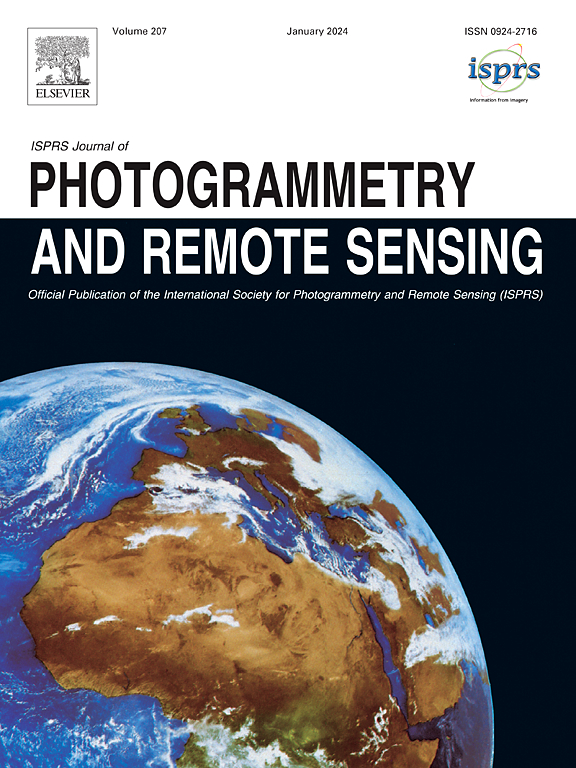Realistic virtual forests for understanding forest disturbances and recovery from space
IF 10.6
1区 地球科学
Q1 GEOGRAPHY, PHYSICAL
ISPRS Journal of Photogrammetry and Remote Sensing
Pub Date : 2025-06-27
DOI:10.1016/j.isprsjprs.2025.06.031
引用次数: 0
Abstract
Forests worldwide are undergoing large-scale and unprecedented changes in terms of structure and composition due to land use change and natural disturbances. We have some understanding of how disturbances impact forest structure. Still, we lack knowledge of the structural impact at fine spatial and temporal resolution, as well as across large spatial extents. Here, we provide a perspective on new approaches to observe, quantify and understand forest disturbances and recovery from space by using time series of the most detailed 3D virtual forest models that aim to digitise real-life forests fully. These virtual forests are important for enhancing our fundamental understanding of how we observe forest disturbance and recovery monitoring from space. We define virtual forests in the context of this paper as explicit 3D reconstructed models that are parameterised so they can be used and manipulated for radiative transfer modelling. Realistic virtual forests can be created through empirical reconstruction of explicit forest structure measured by terrestrial laser scanning, coupled with radiometric parameterisation. We argue that these realistic virtual forests, capturing the temporal dimension of forest disturbances, combined with physically-based radiative transfer modelling, provide a critical link between detailed in situ observations and large spatial coverage from satellite observations.

现实的虚拟森林,了解森林干扰和恢复从空间
由于土地利用变化和自然干扰,世界各地的森林在结构和组成方面正在发生大规模和前所未有的变化。我们对干扰如何影响森林结构有了一些了解。尽管如此,我们仍然缺乏在精细空间和时间分辨率上以及在大空间范围内的结构影响的知识。在这里,我们提供了一个新的视角,通过使用最详细的3D虚拟森林模型的时间序列来观察、量化和理解森林干扰和从空间恢复的新方法,旨在将现实生活中的森林完全数字化。这些虚拟森林对于增强我们对如何从空间观察森林干扰和恢复监测的基本理解非常重要。在本文中,我们将虚拟森林定义为明确的3D重建模型,这些模型被参数化,因此它们可以用于和操纵辐射传输建模。通过地面激光扫描测量的明确森林结构的经验重建,再加上辐射参数化,可以创建逼真的虚拟森林。我们认为,这些真实的虚拟森林,捕捉森林扰动的时间维度,结合基于物理的辐射传输模型,提供了详细的原位观测和卫星观测的大空间覆盖之间的关键联系。
本文章由计算机程序翻译,如有差异,请以英文原文为准。
求助全文
约1分钟内获得全文
求助全文
来源期刊

ISPRS Journal of Photogrammetry and Remote Sensing
工程技术-成像科学与照相技术
CiteScore
21.00
自引率
6.30%
发文量
273
审稿时长
40 days
期刊介绍:
The ISPRS Journal of Photogrammetry and Remote Sensing (P&RS) serves as the official journal of the International Society for Photogrammetry and Remote Sensing (ISPRS). It acts as a platform for scientists and professionals worldwide who are involved in various disciplines that utilize photogrammetry, remote sensing, spatial information systems, computer vision, and related fields. The journal aims to facilitate communication and dissemination of advancements in these disciplines, while also acting as a comprehensive source of reference and archive.
P&RS endeavors to publish high-quality, peer-reviewed research papers that are preferably original and have not been published before. These papers can cover scientific/research, technological development, or application/practical aspects. Additionally, the journal welcomes papers that are based on presentations from ISPRS meetings, as long as they are considered significant contributions to the aforementioned fields.
In particular, P&RS encourages the submission of papers that are of broad scientific interest, showcase innovative applications (especially in emerging fields), have an interdisciplinary focus, discuss topics that have received limited attention in P&RS or related journals, or explore new directions in scientific or professional realms. It is preferred that theoretical papers include practical applications, while papers focusing on systems and applications should include a theoretical background.
 求助内容:
求助内容: 应助结果提醒方式:
应助结果提醒方式:


